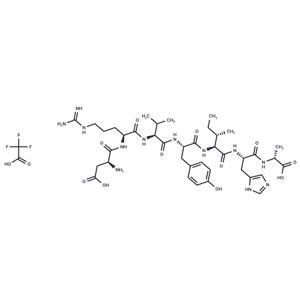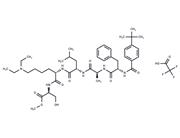| Name | A 779 TFA(159432-28-7 free base) |
| Description | A 779 TFA is a potent antagonist of angiotensin-(1-7) receptor. |
| Cell Research | HUVECs were cultured in vitro and divided into six groups:?the control group (normal medium), the ox-LDL group(treated with 75 mg/L ox-LDL), the ox-LDL+ Ang-(1-7) group (1 μmol/L Ang-(1-7) pretreated for 30 minutes, then intervened with 75 mg/L ox-LDL), the ox-LDL+ Ang-(1-7)+ A-779 group(1 μmol/L A-779 (Mas receptor) pretreated for 30 minutes, 1 μmol/L Ang-(1-7) pretreated for 30 minutes, then intervened with 75 mg/L ox-LDL), the ox-LDL+ A-779 group (1 μmol/L A-779 pretreated for 30 minutes, then intervened with 75 mg/L ox-LDL),?the ox-LDL+ HTA125 group (10 μg/L HTA125 (TLR4-blocking antibody) pretreated for 30 minutes, then intervened with 75 mg/L ox-LDL ).?The corresponding index was detected after 24 hours after intervention.?Apoptosis of cells were detected by Annexin V-FITC/PI double staining flow cytometry and transferase-mediated deoxyuridine triphosphate-biotin nick end labeling (TUNEL).?The generation of reactive oxygen species (ROS), products in oxidative stress, were detected by DCFH-DA staining.?The mRNA and protein expression levels of NADPH oxidase 4(NOX4) and TLR4 were detected by real-time reverse transcription-polymerase chain reaction (RT-PCR) and Western blotting analysis respectively[1].
|
| In vitro | A 779suppresses the proliferating cell nuclear antigen (PCNA) protein expression up-regulated by Ang II, but A 779alone has no effect to induce proliferation and migration of VSMCs.Pretreatment with Ang-(1-7) significantly retards Ang II-induced inflammatory responses of VSMCs associated with up-regulated MCP-1, VCAM-1 and IL-1β expressions, and this effect of Ang-(1-7) is blocked by A-779.But A 779alone has no effect to induce inflammatory response of VSMCs[1]. |
| In vivo | Inhibition of Ang1-7 cascade by A 779significantly eradicated captopril protective effects on bone metabolism, mineralization and micro-structure.A 779also restored OVX effects on RANKL expression and ACE-1/AngII/AT1R cascade and down-regulated OPG expression and ACE-2/Ang1-7/Mas pathway.In line with the clinical observations of the bone-preservative properties following ACE-1 inhibition, local activation of ACE-2/Ang1-7/Mas signaling and suppressed osteoclastogenesis seem responsible for the osteo-preservative effect of captopril, which could offers a potential therapeutic value in treatment of disabling bone and skeletal muscular diseases[2]. |
| Storage | Powder: -20°C for 3 years | In solvent: -80°C for 1 year | Shipping with blue ice/Shipping at ambient temperature. |
| Solubility Information | DMSO : 9.87 mg/mL (10 mM), Sonication is recommended.
|
| Keywords | Angiotensin Receptor | A 779 TFA(159432-28-7 free base) | A 779 TFA(159432287 free base) | A 779 TFA(159432 28 7 free base) |
| Inhibitors Related | Olmesartan Medoxomil | Losartan potassium | Tranilast | Enalapril Maleate | Azilsartan Methyl Ester | Sacubitril/Valsartan | Azilsartan | Irbesartan | Losartan | Ramipril | Captopril | Valsartan Methyl Ester |
| Related Compound Libraries | Bioactive Compound Library | Membrane Protein-targeted Compound Library | Inhibitor Library | Endocrinology-Hormone Compound Library | NO PAINS Compound Library | Bioactive Compounds Library Max | Anti-Hypertension Compound Library |

 United States
United States






